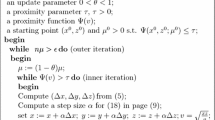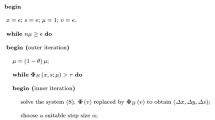Abstract
In this paper, a new class of kernel functions is introduced. We show that most existing kernel functions belong to this class. All functions in the new class are eligible in the sense of Bai et al. (SIAM J Optim 15(1):101–128, 2004), and hence the analysis of the resulting interior-point methods can follow the scheme proposed in Bai et al. (2004). We introduce five new kernel functions and by using this scheme we show that primal-dual IPMs based on these functions enjoy the best known iteration bound for large-update methods, i.e., \(O(\sqrt{n}\log n\log \frac{n}{\epsilon }).\) Finally, to demonstrate the efficiency of IPMs based on the new kernel functions, some numerical results are provided.
Similar content being viewed by others
References
Amini K, Peyghami MR (2006) Complexity analysis of interior-point methods for linear optimization based on some conditions on kernel function. Appl Math Comput 176:194–207
Bai YQ, El Ghami M, Roos C (2004) A comparative study of kernel functions for primal-dual interior-point algorithms in linear optimization. SIAM J Optim 15(1):101–128
Bai YQ, El Ghami M, Roos C (2003) A new efficient large-updat primal-dual interior-point method based on a finite barrier. SIAM J Optim 13(3):766–782
Bouafia M, Benterki D, Yassine A (2016) An efficient primal-dual interior point method for linear programming problems based on a new kernel function with a trigonometric barrier term. J Optim Theory Appl 170(2):528–545
Cai XZ, Wang GQ, El Ghami M, Yue YJ Complexity analysis of primal-dual interior-point methods for linear optimization based on a new parametric kernel function with a trigonometric barrier term. Abstr Appl Anal (2014). https://doi.org/10.1155/2014/710158
El Ghamia M, Ivanov I, Melissen JBM, Roos C, Steihaug T (2009) A polynomial-time algorithm for linear optimization based on a new class of kernel functions. J Comput Appl Math 224:500–513
El Ghami M, Guennoun ZA, Boula S, Steihaug T (2012) Interior-point methods for linear optimization based on a kernel function with a trigonometric barrier term. J Comput Appl Math 236:3613–3623
Fathi-Hafshejani S, Fakharzadeh JA, Peyghami MR (2018) A unified complexity analysis of interior point methods for semidefinite problems based on trigonometric kernel functions. Optimization 67(1):113–137
Fathi-Hafshejani S, Mansouri H, Peyghami MR (2016) A large-update primal-dual interior-point algorithm for second-order cone optimization based on a new proximity function. Optimization 65(7):1477–1496
Fathi-Hafshejani S, Fatemi M, Peyghami MR (2015) An interior-point method for P*(κ)-linear complementarity problem based on a trigonometric kernel function. J Appl Math Comput 48:111–128
Güler O (1994) Limiting behavior of the weighted central paths in linear programming. Math Program 65:347–363
Karmarkar NK (1984) A new polynomial-time algorithm for linear programming. In: Proceedings of the 16th annual ACM symposium on theory of computing, pp 302–311
Kheirfam B (2012) Primal-dual interior-point algorithm for semidefinite optimization based on a new kernel function with trigonometric barrier term. Numer Algorithms 61:659–680
Kheirfam B (2017) A primal-dual interior-point algorithm for symmetric optimization based on a new kernel function with trigonometric barrier term yielding the best known iteration bounds. Afr Mat 28:389–406
Kojima M, Mizuno S, Yoshise A (1989) A primal-dual interior point algorithm for linear programming. In: Megiddo N (ed) Progress in mathematical programming: interior point and related methods. Springer, New York, pp 29–47
Lee YH, Cho YY, Cho GM (2014) Interior-point algorithms for P*(κ)-LCP based on a new class of kernel functions. J Glob Optim 58:137–149
Lesaja G, Roos C (2010) Unified analysis of kernel-based interior-point methods for P*(κ)-linear complementarity problems. SIAM J Optim 20:3014–3039
Li X, Zhang M, Chen Y (2017) An interior-point algorithm for P*(κ)-LCP based on a new trigonometric kernel function with a double barrier term. J Appl Math Comput 53:487–506
Li X, Zhang M (2015) Interior-point algorithm for linear optimization based on a new trigonometric kernel function. Oper Res Lett 43:471–475
Liu Y, Bai YQ (2009) 13(2):95–101
Megiddo N (1989) Pathways to the optimal set in linear programming. In: Megiddo N (ed) Progress in mathematical programming: interior point and related methods. Springer, New York, pp 131–158
Meszaros CS (1999) Steplengths in interior-point algorithms of quadratic programming. Oper Res Lett 213:39–45
Monteiro RDC, Adler I (1989) Interior-point path following primal-dual algorithms: Part I: linear programming. Math Program 44:27–41
Nesterov YE, Nemirovskii AS (1994) Interior point polynomial algorithms in convex programming. In: SIAM studies in applied mathematics, vol 13, SIAM, Philadelphia, PA
Peng J, Roos C, Terlaky T (2002) Self-eegularity a new paradigm for primal-dual interior-point algorithms. Princeton University Press, Princeton
Peyghami MR, Fathi-Hafshejani S (2014) Complexity analysis of an interior-point algorithm for linear optimization based on a new poriximity function. Numer Algorithms 67:33–48
Peyghami MR, Fathi-Hafshejani S, Shirvani L (2014) Complexity of interior-point methods for linear optimization based on a new trigonometric kernel function. J Comput Appl Math 255:74–85
Peyghami MR, Fathi-Hafshejani S, Chen S (2016) A prima dual interior-point method for semidefinite optimization based on a class of trigonometric barrier functions. Oper Res Lett 44:319–323
Roos C, Terlaky T, Vial J-P (2005) Theory and algorithms for linear optimization: an interior point approach. Springer, New York
Sonnevend G (1986) An analytic center for polyhedrons and new classes of global algorithms for linear (smooth, convex) programming. In: Prakopa A, Szelezsan J, Strazicky B (eds) Lecture Notes in Control and Information Sciences, vol 84. Springer, Berlin, pp 866–876
Acknowledgements
The authors would like to thank Professor M. Reza Peyghami for his valuable comments and suggestions on the earliest draft of the manuscript.
Author information
Authors and Affiliations
Corresponding author
Additional information
Publisher's Note
Springer Nature remains neutral with regard to jurisdictional claims in published maps and institutional affiliations.
Appendix
Appendix
In this section, we prove that the five new kernel functions defined in Sect. 5 satisfy the conditions (9)–(11). To this end, it is clear that the first property, i.e., \(f_i(1) = 0\) and \(\lim _{t\mapsto 0^+}f_i(t)=+\infty\) ares true for all new functions \(f_i(t)\). Thus we just demonstrate that these functions satisfy the second and third conditions.
Lemma 8.1
For the new proposed functions \(f_i(t)\), \(i=1,2,\ldots ,5\) the relations (10) and (11) are true:
Proof
To prove the first item, it is enough to prove the inequality \(2t-(tf_i'(t)+1)\exp (f_i(t))>0,\) \(i=1,2,\ldots ,5\) is true. Using \(f_i(1)=0\) and the fact that \(f_i\)’s are strictly decreasing function (i.e., \(f_i'(t)<0\) and \(\exp (f_i(t))\le 1\)), for all \(t\ge 1\), we can conclude that:
in which the last inequality is obtained from the fact that \(t\ge 1\).
On the other hand, when \(t\in (0,1]\) it is sufficient to prove that \(-(tf_i'(t)+1)>0\), \(i=1,2,\ldots ,5.\) It is proved as follow:
-
For the first function we have:
$$\begin{aligned} -tf_1'(t)-1=\frac{te^tp(e-1)}{(e^t-1)^2}-1=\frac{te^tp(e-1)-(e^t-1)^2}{(e^t-1)^2}. \end{aligned}$$Since \((e^t-1)^2\)is positive, we demonstrate that the function
$$\begin{aligned} l_1:=te^tp(e-1)-(e^t-1)^2, \end{aligned}$$is positive. To this end, using the fact \(t\in (0, 1]\) and we conclude that \((e-1)\ge (e^t-1)\), which implies that \(l_1\ge (e^t-1)\left( te^tp-e^t+1\right)\). So, we deduce that the function \(l_1\) is positive.
-
For the function \(f_2(t)\), we have:
$$\begin{aligned} -tf_2'(t)-1=\frac{tpe^t}{e^t-1}+\frac{tpe^t(e-1)}{(e^t-1)^2}-1>0, \end{aligned}$$where the inequality is obtained by applying the first part of lemma and the fact that \(\frac{pe^t}{e^t-1}\) is positive for all \(t>0\).
-
By considering the third function, we see that:
$$\begin{aligned} -tf_3'(t)-1=2p+\frac{2p\pi t}{(2+2t)^2}\left( 1+\tan ^2\left( \frac{\pi }{2+2t}\right) \right) -1>0, \end{aligned}$$where the last inequality is derived from the fact that \(p\ge 1\) and \(\tan (\frac{\pi }{2+2t})\) is positive for all \(t>0\).
-
The forth function, i.e., \(f_4(t)\) gives us:
$$\begin{aligned} -tf_4'(t)-1= p+\frac{r p}{t}e^{p(\frac{1}{t}-1)}-1>0. \end{aligned}$$ -
We can use the proof of \(f_1\) for the \(f_5\); so it is omitted here.
Using the fact the functions \(f_i(t)\), \(i=1,2,\ldots ,5\), are strictly decreasing and one can easily conclude that these functions satisfy the condition (11).
The next goal in this section is to prove that the functions \(f_i(t)\), \(i=1,2,\ldots ,5\) are convex. By regarding (Bai et al. 2004), it is enough to show that their second derivative are positive. Their second derivative are presented in Table 13. Obviously all of them are positive.
\(\square\)
Rights and permissions
About this article
Cite this article
Fathi-Hafshejani, S., Moaberfard, Z. A generic kernel function for interior point methods. Optim Eng 22, 261–291 (2021). https://doi.org/10.1007/s11081-020-09512-z
Received:
Revised:
Accepted:
Published:
Issue Date:
DOI: https://doi.org/10.1007/s11081-020-09512-z




